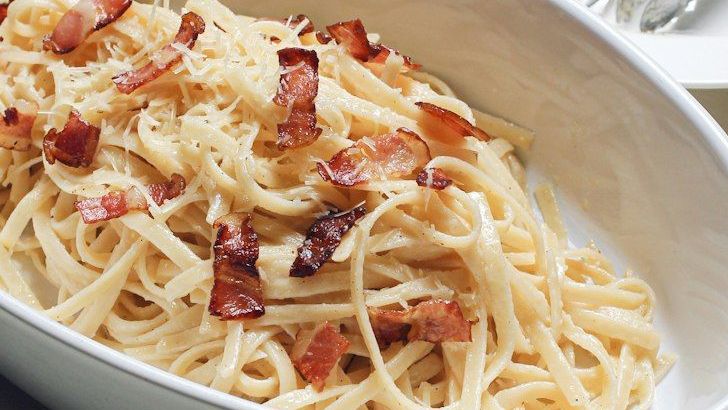Fettuccine Alfredo: The Dish That Almost Doesn’t Exist in Italy

Fettuccine Alfredo, it turns out, is 100% Italian. To be fair, the original recipe is quite different from whatever you may find in the States. Italians have been eating Fettuccine Alfredo for over a century… They just didn’t know that’s what it was called! The dish was actually created by Alfredo di Lelio in Rome in 1908, but what Americans call “Alfredo” bears little resemblance to the original.
Fettuccine Alfredo is still presented the original way with “a very simple recipe and a little theatricality”, as Mozzetti explains. I see what he means: before serving it, waiters mix the pasta with parmesan cheese right in front of you with ample and elegant movements. The authentic version uses just butter, pasta water, and Parmigiano-Reggiano cheese – no cream in sight. Alfredo sauce is an Italian specialty made with a base of butter or heavy cream mixed with Parmesan cheese. Making Alfredo sauce involves sautéing garlic and butter together, adding heavy cream, and stirring until it becomes thick and creamy.
The American transformation happened thanks to Hollywood royalty. In 1920, Mary Pickford and Douglas Fairbanks, the brightest stars of the American silent film era, are visiting Rome for their honeymoon. Fate brings the couple to Alfredo’s restaurant, where they fall in love with his fettuccine. Back in Hollywood, they begin to spread the word about the restaurant among their friends and guests, including notable personalities like George Bernard Shaw, Albert Einstein, Francis Scott Fitzgerald and Amelia Earhart. But somewhere along the way, the simple Roman recipe got lost in translation. Well actually almost nobody, there is a restaurant in Rome called “Alfredo” wich claim to be the house of the original sauce but is something for tourists because italians don’t use alfredo’sauce. The closest is just called “burro e parmigiano” (butter and parmesan) without tons of cream and is not just for fettuccine but any shape of pasta.
Carbonara: The Cream-Free Classic That Americans Keep “Improving”

Carbonara is an Italian sauce made with egg, cheese, and diced guanciale (cured pork cheek). Carbonara sauce does not feature heavy cream – the dish derives its creaminess from the emulsion of egg yolks with cheese and starchy pasta water. This simple Roman dish has become one of the most butchered recipes in American kitchens, with countless variations that would horrify any Italian chef.
This is very important for me because I’m roman and Carbonara is the most iconic roman pasta. Pasta shapes allowed: spaghetti, bucatini, rigatoni, mezze maniche. Ingredients for sauce: eggs, pecorino romano cheese, black pepper, guanciale (pork cheek). That’s it – five ingredients maximum. Yet American versions regularly feature cream, peas, mushrooms, chicken, and other additions that transform the dish into something completely different. You see, real carbonara sauce is made from pecorino romano cheese, egg, pasta water (and oftentimes guanciale fat); Olive Garden’s version for these dishes doesn’t contain any egg at all. Instead, according to a Reddit thread on r/OliveGarden, it’s composed of “cold alfredo sauce base and bacon crumbles mixed together,” according to one commenter, while another added that at their restaurant, they also put grated parmesan cheese into the mix.
The cooking technique matters just as much as the ingredients. Carbonara also happens to be the more challenging of the two to make, requiring a delicate management of heat and ingredients to achieve that lighter texture. Alfredo is much simpler and an easy Italian-style pasta dish to master even for beginners. Despite the creaminess of both dishes, the biggest difference in ingredients is that the sauce for carbonara isn’t dairy based at all. Alfredo, on the other hand, is a wildly rich combination that involves butter and cream as the base of the sauce. The magic happens when hot pasta meets the egg mixture, creating a silky coating without any cream whatsoever.
Chicken Parmesan: America’s Meaty Take on Eggplant Tradition

The dish originated in the Italian diaspora in the United States during the early 20th century. It has been speculated that the dish is based on a combination of the Italian parmigiana, a dish using fried eggplant slices and tomato sauce, with a cotoletta, a breaded veal cutlet generally served without sauce or cheese in Italy. What Americans call chicken parmesan is actually a clever adaptation created by Italian immigrants who discovered that meat was much more affordable in their new country.
In the Old World, that’s Italy prior to the Italian diaspora – the large-scale emigration of Italians from Italy to America – proteins like chicken were not widely available. As such, the prototypical chicken parmigiana was actually made with breaded, fried slices of eggplant in place of chicken for a dish called melanzane alla Parmigiana. The original eggplant version remains a staple in Italian homes, where it’s considered comfort food made from simple, affordable ingredients. Eggplant parm was known as a “la cucina povera” dish, which means “from the kitchen of the poor”. It was based on eggplant, often grown in local gardens, combined with ingredients that even the poorest of families would have on hand.
When Italians arrived in America long ago, they found the expensive proteins of their homeland were far more affordable and accessible in the meat markets of the new world. Such proteins included pork, beef, and veal, which all became wildly popular ingredients in many “new” favorites, including another Italian-American creation, the mighty meatball. These newly minted Italian-American homecooks not only devised unique dishes based on what was available, but also adhered existing recipes to the new world’s meat-centric menu – altering many classics into newfound creations, including chicken parmigiana. It didn’t start to dominate the U.S. around the 1950s, but that popularity is as widespread as ever today. Once it started appearing in recipe books and Italian restaurants, chicken parmigiana became a fan favorite worldwide.






![BREAKING: Rob Reiner & Wife Were Killed by Their Son Who Battled Drug Addiction [Reports]](https://everyday-states.com/wp-content/uploads/2025/12/1765818844773_rob_reiner.0842.jpeg)